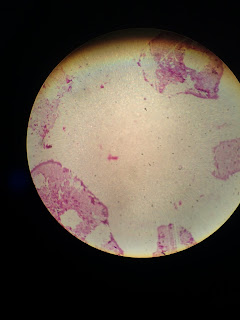There is a great deal of nutritional diversity among microorganisms. Therefore, microbial growth is greatly affected by the nutrients that are available in their environment. As such a culture media, which purpose is to provide nutrient for the growth of microorganisms or cells must be prepared and sterilize thoroughly.
Culture media that is often used in a laboratory
setting can be classified into two (2), a complex media or a defined media. Complex
media are composed of extracts from biological sources which components are
unknown while a defined media is a media with known constituents. For this lab,
preparation of sterile nutrient agar for culturing microorganisms will be the
main objectives.
Although there is nutrient agar which is available
commercially, it is also vital for a student in microbiology to know what constitute
a culture media. Thus, several type of culture media will be prepared which
includes BHI agar, TSAYE agar, commercial nutrient agar and a self-made
nutrient agar. The self-made nutrient agar will contains:
1.5 g/L
"Lab-lemco" powder (a beef extract)
1.5 g/L yeast extract
5.0 g/L peptone (a nitrogen source)
5.0 g/L sodium chloride
15.0 g/L agar powder
1.5 g/L yeast extract
5.0 g/L peptone (a nitrogen source)
5.0 g/L sodium chloride
15.0 g/L agar powder
It should also be known that the nutrient agar is initially a
liquid media or a nutrient broth which is mixed with agar and poured via sterile media
dispenser into Petri dishes to solidify.
Next, a culture media
can be sterilized using a process known as autoclaving. It is proceeds with an autoclave
which is basically a pressure chamber that is sealed off against surrounding air
and functions similarly like a large pressure cooker. The exact conditions for
autoclaving includes temperature of 121 °C under the pressure of 15 psi or
103 kPa for 15 minutes.
Objective
To prepare sterile nutrient agar for culturing microorganisms
Materials and reagents
Commercial nutrient agar
Balance
Distilled water
Scott bottles
Procedure
(refer to lab manual)
Results
Objective
To prepare sterile nutrient agar for culturing microorganisms
Materials and reagents
Commercial nutrient agar
Balance
Distilled water
Scott bottles
Procedure
(refer to lab manual)
Results
4 culture media has been prepared. There are 400 ml
of nutrient agar, 400 ml of self-made nutrient agar, 100 ml of BHI agar and 100 ml
of TSAYE agar.
For the self-made nutrient agar, the recipe is as
stated below:
‘Lab-lemco powder’ (a beef extract) 0.6 g/ml
Yeast extract 0.6 g/ml
Peptone 2.0 g/ml
Sodium chloride 2.0 g/ml
Agar powder 6.0g /ml
Auto-claving
Discussion
- The surface of the balance must be cleaned before
weighing the culture media powder to get more accurate reading.
- All of the doors of the electronic balance are
closed before weighing.
- The draft shield is closed completely and zero
using the "Tare" key on balance display. This will clear any previous
tare or cancel any zero-drift.
- All the apparatus are cleaned with distilled water
before used to avoid contamination.
-The Scott bottles are labeled with the name of
culture media (nutrient agar, self-made nutrient agar, BHI agar and TSAYE
agar) so that it easy for us to differentiate them.
- All of the media are stirred well with a spatula to
ensure that the powders from cultural medium mixed well with the distilled
water.
-The caps of the Scott bottles are recapped loosely to
prevent the Scott bottles from breaking during the autoclaving.
-All of the Scott bottles which contain the
different medium are placed into a special basket then the whole basket is put
into the autoclave chamber for sterilization.
-All the media are sterilized at 121 °C and 103 kPa
(15psi) for 15 minutes. Under these conditions, all organisms and their
endospores will be killed.
-After autoclaving, the exhaust of autoclaving
machine must be opened to lower the pressure until the pressure is same as
atmospheric pressure.
Conclusion
The preparation of nutrient agar for the culturing microorganism is done by using autoclaving technique in order the material to be sterilized. Higher temperature ensure more rapid killing. It is very important to ensure that all the trapped air is removed.
Proper autoclaved treatment will inactive all fungi bacteria, viruses and also bacterial spores which can be quite resistant, if not necessarily eliminate all prions.
Reference













